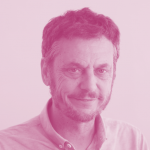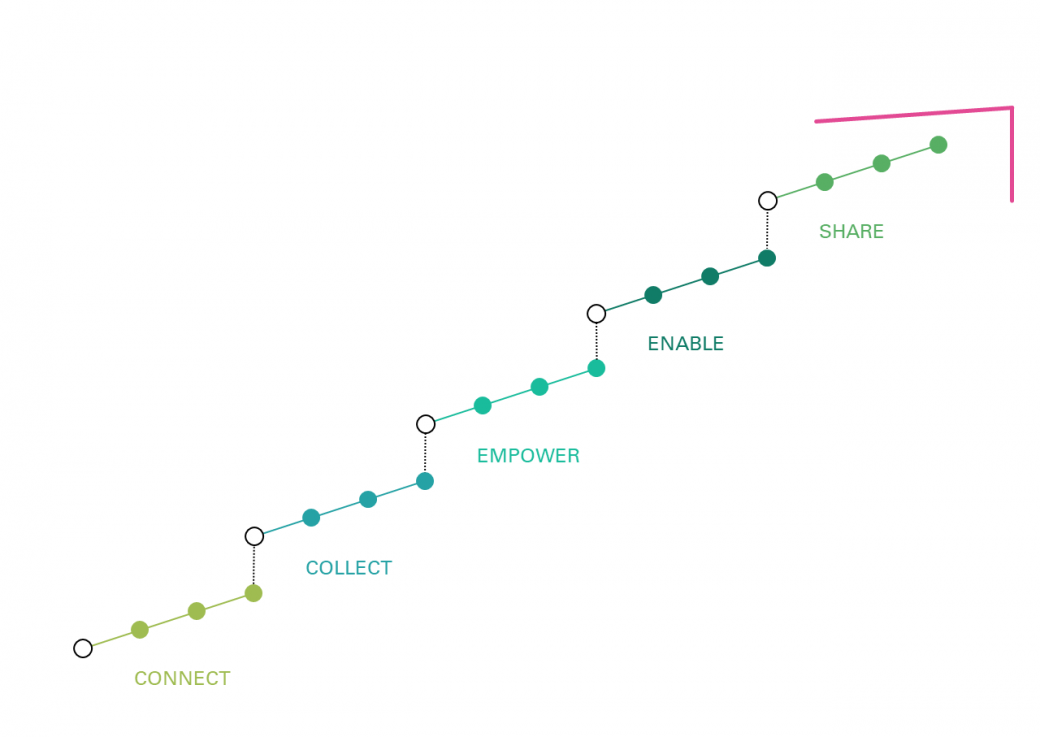“The higher the goals that an organization sets, and climate mitigation is undoubtedly one of the most ambitious we can now think about, the more energizing the process becomes. We have observed that backcasting from the future to today, imagining breakthrough solutions rather than incremental gains which build from the present, allows all sorts of organizations to free themselves from historical constraints and fears towards the existing ‘immunological systems’ that resist structural change. Focusing on future possibilities, people become more open, inclusive, collaborative and optimistic, thus increasing their capacity as agents of change,” says Javier Creus.
Javier Creus is the Founder and CEO of Ideas for Change, and the creator of the Pentagrowth methodology. With Pentagrowth, Ideas for Change helps organizations to design strategies with exponential growth potential and guide them through the first steps of their implementation process. Javier Creus is considered to be one of the primary strategists and thought leaders in collaborative economy, open and P2P business models, citizen innovation and the networked society. Contact Javier Creus in regard of the Pentagrowth methodology.
Sebastian Klemm: What makes the Pentagrowth system an effective methodology for companies, startups as well as public authorities to design future proof organizations and business models?

Javier Creus: We are in need of better systems in almost all key functions in our society: energy, mobility, education, health. We are pretty much aware of the challenges each of these systems face, but we rarely leverage the solutions we devise on technological and social innovation that will accelerate change and provide new opportunities.
Companies: Established companies are usually trapped in “path dependent” visions. They put almost all their research and innovation efforts into making better what they already do well, incremental innovation. However, datafication has erased frontiers among sectors and industries, and disruptors come either from nowhere or from adjacent industries. Pentagrowth helps incumbents anticipate “creative destruction”, unbundle their assets and capacities with emerging technologies so they can become disruptors themselves rather than being disrupted.
Startups: Newly founded companies have no legacy, so their business models have to aim to generate and capture “new value”, social functions which might not be widely possible now, but that will become the new standard as the emergent technologies in which they leverage become adopted. Pentagrowth helps startups stream and focus their value proposition and anticipate technological deployments that will accelerate their growth.
Public authorities: New systems are not anymore a game of two: private corporations and public institutions. We have already witnessed how each new technological wave enables citizens to individually and collectively become active producers and economical agents beyond being passive consumers and service takers. Public institutions need to integrate these new citizen capacities to design new services that actually solve citizens’ concerns.

Sebastian Klemm: Many companies, startups and municipalities pledge for climate mitigation goals that consequently require them to apply business model innovation & transform traditional operations in order to achieve the goals they set for themselves.
How can your Pentagrowth methodology support organizations to leverage their abundance of talent, data, capacity and capability to be able to strengthen their climate action?

Javier Creus: The higher the goals that an organization sets, and climate mitigation is undoubtedly one of the most ambitious we can now think about, the more energizing the process becomes.
We have observed that backcasting from the future to today, imagining breakthrough solutions rather than incremental gains which build from the present, allows all sorts of organizations to free themselves from historical constraints and fears towards the existing “immunological systems” that resist structural change. Focusing on future possibilities, people become more open, inclusive, collaborative and optimistic, thus increasing their capacity as agents of change.
Once a group of people allows themselves to think with intellectual freedom, they spontaneously discover and put to work all sorts of resources and capabilities that were buried under the existing mental framework.

Sebastian Klemm: The 5 levers of growth identified by your research and applied in your Pentagrowth method are “Connect Network”, “Collect Inventory”, “Empower Users”, “Enable Partners” and “Share Knowledge”. Can you outline how moving along each of these levers increases the potential for growth in an organization?

Javier Creus: These five levers synthesize the data analysis we carried among 50 organizations that have grown more than 50% in users and income year by year during five years in a row. What we found out is that all their disruptive business models could be explained by combining at least two of these levers.
Disruptive business models leverage on the deployment of emergent communication networks that allow to connect things that were up to then disconnect and ideate new forms of value out of them. What we observed is that each generation grew at double speed than the one it preceded. We are now in the IoT + AI generation. The more nodes you connect – places, people, situations, things – the bigger your growth potential. “Connect networks”.
Disruptive business models rely not only on their own assets, but they are capable of building their stock by accessing distributed infra utilized assets as Airbnb does with apartments or open assets as open data or software. The less effort you have to put into building your inventory, the faster you can grow. “Collect inventory”.
Disruptive business models take advantage of citizens’ productive capacities enabled by new technologies, producing data, content, photos or videos as youtube does, or they design interactions among users themselves that create new value as Linkedin has done first among job providers and searchers and afterwards among content creators and consumers. Growth potential increases as work is not done by the organization’s personnel but by its users themselves. “Empower citizens”.
Disruption in industries occurs when a new standard is widely adopted. Most standards are generated by a loose alliance of cooperative – competing agents that collaborate to conform a new business ecosystem. Apple launched it’s Apple market just one year after the launch of the iPhone in 2007, rather than contracting providers it offered anyone a shared income deal on apps. Two years later Google offered Android for free to any device manufacturer, thus becoming the standard OS in the mobile era in very few years. Competition is not anymore among companies but among business ecosystems. The greater and more diverse businesses that build their business on top of yours, the bigger the growth potential. “Enable partners”.
Disruption in industries can be promoted by communities sharing knowledge they might even produce themselves. Wikipedia has erased the encyclopedia industry by relying on citizens to produce and update its content and finance its operations through donations. The larger the community that considers worth preserving what you share, the faster you can grow. “Share knowledge”.

Sebastian Klemm: From a 2 day bootcamp to long-term support: Can you give examples on how you have already been adapting the Pentagrowth method to different needs of startups, accelerator programmes as well as business model innovation phases within companies and organizational change in public authorities?

Javier Creus: We always run the Pentagrowth process with teams, made up of 5 or 7 people with different knowledge and capabilities. When working with a large corporation or a whole system we can run the process with up to ten teams in parallel with the help of our Pentagrowth certificates and using our online Pentagrowth academy for participants to keep up with weekly assignments.
The ideation process consists of four steps:
- anticipate: exploring the possibilities of the next technological and social wave which leads to the definition of a #future-that-rocks
- unbundle: reevaluating the potential contribution of existing assets to that #future-that-rocks which ends by identifying those with higher future potential
- explore: how the five levers of exponential growth will be available in the future system configuration, which ends by selecting those that could most contribute to a disruptive business model
- combine: internal valuable assets with available system levers to design new value propositions which generate far more value than is needed to sustain the organization. After ideation, we support our clients in validating and prototyping their envisaged solutions, and end up with a Go/No go, In/Out recommendation as to how to move forward.
We can run the process in an express mode in two full days of work by prior investing enough research and framing time to provide a mind shaking scenario for participants in the anticipation step. This is useful when our client wants to gather it’s business ecosystem to explore possibilities that they will later develop further.
During the Covid-19 pandemic we designed and ran a five week process called “Pentagrowth Quick Wins” for a single team in which we searched for a tweak in the existing business model to advance Post-Covid business environments.
When working with corporations we usually propose a full Pentagrowth sprint with the participation of at least four different teams with weekly meetings and assignments. At this pace of work we can warranty the design of at least one promising business model for each team which we can validate, prototype and evaluate in the next following three months.

Contact: You are welcome to contact Javier Creus in regard of the Pentagrowth methodology.
Resources: You can download the Pentagrowth Report in English & Spanish here.








